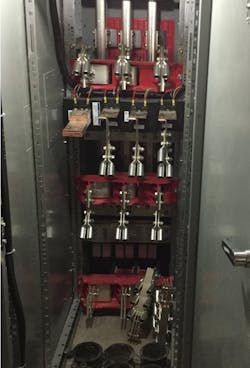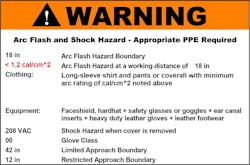If you are responsible for facility electrical operations, you may have heard of the recent updates to IEEE 1584 “IEEE Guide for Performing Arc-Flash Hazard Calculations.” The previous major edition of the standard was released in 2002. A lot has changed in this 16-year span, which led to many revisions in the 2018 version of the guide.
Understanding what changed, why it changed, and how that bears out for incident energy calculations will help to clarify the impact on operations and maintenance. Here are some of the most significant changes discussed in this article:
• Arc flash model updates — Arcing current and incident energy calculations were updated based on the latest research, so they will be different, even if the electrical system has not changed.
• Bus configuration — The orientation of the buses inside the equipment now has a significant impact on the incident energy, and must be considered.
• Enclosure size — If the equipment has an enclosure, the box dimensions have an impact on incident energy, and must be considered.
• 125kVA transformer exception — The exemption for systems downstream of a 125kVA transformer has been removed.
As an example of how arc flash assessments can change under the 2018 guide, an existing laboratory facility was used as a test case and is presented here. In this discussion, low-voltage systems under 600V will primarily be considered, although some may also pertain to higher-voltage systems.
Background
The 2002 version of IEEE 1584 represented a broad industry consensus on how to calculate the heat energy that electrical workers may be exposed to during an arc flash. Although not perfect, it provided a better measure of AC arc flash hazards than those available before and — quoting from the introduction to the new IEEE 1584 document — “has been used with success throughout industry.” Through further research and testing, it was identified that the incident energy given by the 2002 model was too low or too high for some equipment conditions. The 2018 version provides a greatly refined model that incorporates more details of equipment configuration, resulting in more accurate incident energy calculations in many cases.
Arc Flash Model Updates
One of the most significant updates in the new 1584 is the introduction of new equations for arcing current, arc flash boundary, and incident energy. The past 16 years of experiments have yielded a volume of data on arcing current and incident energy that is matched better by the new equations. Therefore, arcing currents will be different when calculated using the 2018 method compared to the 2002 method, even with the same system parameters and available short-circuit current.
The same goes for incident energy. The next time you update your arc flash hazard assessment, prepare to see different incident energy values than before, even if the system configuration has not changed at all. Despite the breadth of these changes, many of the changes in incident energy may be small, and, depending on your facility’s PPE standard, may require no change in the minimum PPE for energized work. The magnitude of the change is heavily influenced by the construction of the electrical equipment, as described next.
Bus Configuration
Two new required inputs to the model are the configuration of conductors inside the equipment and the size of the enclosure. IEEE 1584-2018 describes five different conductor configurations:
• VCB: vertical conductors inside a metal enclosure
• VCBB: vertical conductors terminated in an insulating barrier inside a metal enclosure
• HCB: horizontal conductors inside a metal enclosure
• VOA: vertical conductors in open air
• HOA: horizontal conductors in open air
Most low-voltage work on energized panelboards (Photo 1), switchboards, motor control centers (MCCs), or switches would be considered inside an enclosure (VCB, VCBB, or HCB). An example of an open-air installation would be pole-mounted overhead conductors.
It is possible to encounter different conductor configurations within the same equipment, depending on the work task. IEEE 1584-2018 Annex C provides some guidance on the selection of conductor configuration. For example, within a MCC, the electrode configuration could be VCB or VCBB, depending on the fault location. For low-voltage draw-out switchgear, a fault on the bus studs with a breaker racked out may correspond to the HCB mode (Photo 2).
Much higher incident energy may be predicted by the 1584-2018 calculations using the HCB conductor configuration compared to the 1584-2002 calculations — all else being equal. This is based on experiments that indicate horizontal electrodes direct more of the heat toward the open front of the enclosure than vertical electrodes. Therefore, facilities that regularly perform “hot work” on switchgear or switchboard systems (such as racking in drawout breakers on a hot bus) may want to consider updating their arc flash studies, since it is possible that incident energy is presently under-represented.
Enclosure Size
As previously mentioned, the size of the equipment enclosure must also be considered in the new model. Research has indicated that the walls of an enclosure reflect radiation from the arc back at the front of the box, resulting in higher incident energy compared to arcs in open air. Generally, the larger the enclosure, the lower the incident energy (all else being equal), since the heat is less concentrated over the incident surface. For “shallow” enclosures less than 20 inches in height and width and less than 8 inches in depth, this trend is reversed. Note that, unlike the choice of bus configuration, the selection of enclosure size does not affect the calculation of arcing current — only the incident energy.
Field data gathering efforts for arc flash studies seldom include measurements of box dimensions. Including this in future field data requests could benefit the accuracy of the study, but if this information is not available, appropriate
assumptions based on the guide must be made. Table 8 in IEEE 1584-2018 contains typical enclosure sizes and bus gaps for various types of equipment. Selecting the minimum enclosure dimensions corresponding to the equipment type per Table 8 should yield a conservative result (for any “shallow” enclosures, the maximum size would yield the conservative result).
125kVA Transformer Exception
IEEE 1584-2002 stated that equipment rated 240V and below and downstream of a transformer rated less than 125kVA need not be considered in the study. Since the incident energy was not calculated for this equipment, it was often assumed to be less than 1.2 cal/cm2.
The 2018 version no longer includes this exception in light of research demonstrating that arcs can be sustained at 240V under some conditions. Instead, a new statement has been added, which reads: “Sustainable arcs are possible but less likely in 3-phase systems operating at 240V nominal or less with an available short-circuit current less than 2,000A.” Therefore, equipment downstream of 480-208V transformers rated under 112.5kVA may now need to be considered as part of the arc flash study, depending on the available fault current. Furthermore, the low fault current — and hence low arcing current — on these systems often drives long interrupting times for molded-case circuit breakers, which can result in incident energy much higher than 1.2 cal/cm2.
Test Case: 133-Bus Laboratory Building
Newcomb & Boyd conducted a study on a laboratory facility with 133 buses to compare the results using the IEEE 1584-2002 and 1584-2018 methodologies. The building is served by two medium- voltage network transformers through a 480V switchboard with a main-tie-main configuration. There are three MCCs in the building for mechanical loads. Lighting and plug/process loads are served by two busway risers, which are tapped off on each level with 150kVA, 480-208V transformers to serve the 208Y/120V panels on each floor. Several other 480V panels are tapped off the busway risers to serve miscellaneous loads.
For the 2018 model, conductor configuration had to be selected for each bus. Based on the guidance of Annex C, the VCBB configuration was initially selected for all MCCs, panelboards, enclosed circuit breakers, and disconnects. Further study found the VCBB electrode configuration to result in higher incident energy for all but five panelboards. For these panelboards, the VCB configuration resulted in a lower arcing current and longer interrupting time, producing a higher incident energy than the VCBB configuration. Per Annex C, certain faults within a panelboard are consistent with VCB, so VCB was selected for these five buses. For the MCCs, the VCBB configuration resulted in higher incident energy than VCB, so VCBB was selected.
Since certain faults in switchgear or switchboard draw-out compartments correspond to the HCB configuration, HCB was selected for the service main compartment. This resulted in an incident energy that was 40% higher than that calculated from the 2002 method. The incident energy was also twice what was calculated assuming the conductors were in the VCB configuration, which indicates the importance of selecting an appropriate configuration.
Enclosure sizes were selected based on Table 8 in the 2018 guide. Because larger enclosures typically result in lower incident energy, the minimum enclosure size corresponding to the equipment class was selected to obtain a conservative result. No equipment in the study could be definitively classified as “shallow.”
The incident energy calculation results with the two methods were closely compared. One of the more significant deviations occurred on a 208V panelboard that would not have been considered in the incident energy calculations under the 2002 guide. The incident energy as calculated with the 2018 model was 11.6 cal/cm2, which would require significantly greater PPE to protect against if the panel was worked hot. The other 132 buses in the system exhibited a 22% decrease in incident energy (on average). Using common breakpoints for PPE category (1.2, 4, 8, 25, and 40 cal/cm2), a total of five buses went up in PPE category (higher-rated PPE), and a total of nine buses went down in PPE category. The change in incident energy for all the other buses in the system was not significant enough to trigger a shift in category using the above breakpoints.
This is just one example of one building, and time and experience may offer more insight into how the new 1584 may affect the study results at different types of facilities. Depending on the type of equipment involved, the PPE needed to protect from energized work hazards may change greatly with the new guidance. Regardless, NFPA 70E and OSHA continue to preclude most energized work, except where de-energizing results in a greater hazard or if it is infeasible for the work to be performed. Establishing an electrically safe work condition is the safest way to work on electrical equipment.
Dr. Costley is an electrical engineer with Newcomb & Boyd, an engineering & consulting firm located in Atlanta, where he provides design and consulting services to clients in institutional, government, military, and commercial fields. He is experienced in short circuit, selective coordination, and arc flash studies as well as engineering forensics and custom testing. He can be reached at [email protected].
About the Author
Mitch Costley
Electrical Engineer
Dr. Costley is an electrical engineer with Newcomb & Boyd, an engineering & consulting firm located in Atlanta, where he provides design and consulting services to clients in institutional, government, military, and commercial fields. He is experienced in short circuit, selective coordination, and arc flash studies as
well as engineering forensics and custom testing.



